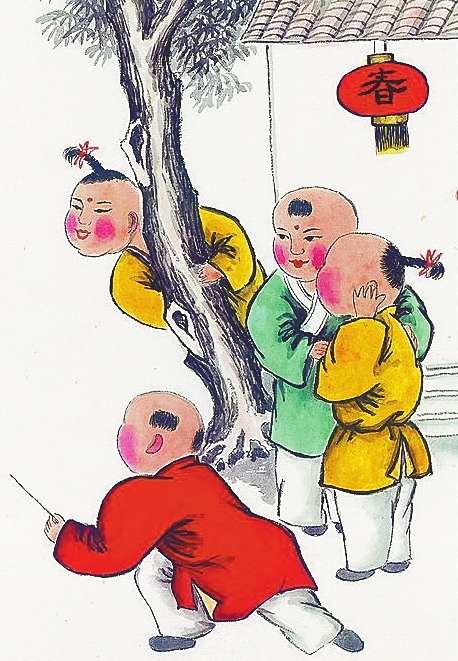
AS the Spring Festival getting close, it’s time to start doing some holiday preparation. Different from other festivals, the traditional Spring Festival lasts more than a month, throughout the second half of Layue (the 12th month) and the first half of Zhengyue (the first month) of the lunar year. But which are the most special days during this festive period, and what do people do on those days? Here is the upcoming festival’s schedule and the related customs. The 24th day of Layue (Jan. 29) Year-end cleaning 扫尘 The 23rd day of Layue in North China and the 24th day of the month in South China are the Xiaonian Festival on the Chinese lunar calendar. Xiaonian is also called “Minor Spring Festival,” symbolizing the start of the Spring Festival. On this day, people usually do house-cleaning. It’s said that most of the gods go back to heaven to state their work in the concluded year, so people can do the cleaning without disturbing or offending them. The 25th day of Layue (Jan. 30) Grinding bean curd 磨豆腐 According to legend, the Jade Emperor, the ruler of heaven, descends to earth to inspect the world on this day and to see if every household lived an honest, frugal, and diligent life. As traditional values lead, people who work hard but live poorly should be shown sympathy and rewarded. To show the frugality and pray for the emperor’s reward, traditionally people make bean curd, or tofu, a cheap food in China. In Northeast China, people make a decent amount of niandoubao, a kind of bun made of glutinous millet stuffed with red bean paste. Niandoubao is also a staple food during the Spring Festival. The 26th day of Layue (Jan. 31) Cooking meat 炖大肉 Many families typically eat pork and cook meat. Other families who don’t raise pigs go to a local market for a hunk of meat. In the agrarian societies of the past, people hardly had a chance to enjoy meat except for during the Spring Festival. The eating of meat also marks the biggest celebration throughout the year. The 27th day of Layue (Feb. 1) Showering, washing clothes 洗疚疾 Do the laundry, and bathe or take a good shower. Those activities symbolize washing off all the bad luck and potential illness in the upcoming Chinese New Year. In places like Beijing and Tianjin, another old tradition is to eat a rooster. Most people prefer a rooster instead of hen because of its majestic look and because they believe it will bring good luck. The 28th day of Layue (Feb. 2) Kneading dough, making cake 发面打年糕 It’s a tradition to prepare in advance all the staple foods the whole family will eat during the first week of Zhengyue (the first month of the Lunar New Year). Usually, the staple food is flour-made because it’s easy to store. The activity starts from the 28th and may last for one or two days. People from North China make steamed buns from leavened doughs, while people in the South prefer year cake, or niangao, made from glutinous rice. The steamed buns can be in various shapes like cute animals, flowers, and more. The 29th day of Layue (Feb. 3) Honoring ancestors 上供请祖 People in most of the areas get up early to sweep tombs for their ancestors and burn incense and joss papers in memory of them. This is also a reflection of the traditional value of “xiao,” or filial piety, in China. The 30th day of Layue (Feb. 4) Spring Festival’s Eve 除夕守岁 Finally, it’s the Spring Festival’s Eve. This day is regarded as the most important day for family reunion throughout the year. Children who work or study outside the hometown return home to celebrate the festival with their family. The whole family enjoys a big feast at night while watching the Spring Festival gala. They stay up late and wait to ring in the New Year. A must-eat food is dumplings. Elders give kids red packets, or red envelopes, with cash in them. In the days between the 28th and the 30th of Layue, people also put on couplets on the gates, paper-cutting decorations on the windows, and New Year pictures on the walls of their homes to express their best wishes. The 1st day of Zhengyue (Feb. 5) New Year greetings 拜年 Embracing the first day of the New Year, people visit friends and relatives’ homes and make New Year’s greetings to each other. They use auspicious words to pray for good luck in the New Year. “Gongxifacai” (congrats for being more prosperous and better off), “wanshi ruyi” (everything goes as you wish), and “shenti jiankang” (being fit and healthy) are among the most frequently given wishes. The 2nd day of Zhengyue (Feb. 6) Married daughters visit childhood homes 回娘家 As married daughters traditionally spent the Spring Festival Eve with their husbands’ families, on this day it’s time to return to their original home and visit their families. Today, this custom is weakened, since more people spend the eve of Chinese New Year in many different ways — not necessarily at their husbands’ homes. The 15th day of Zhengyue (Feb. 19) Lantern Festival 闹元宵 This day is called “Zhengyue shiwu,” or the Lantern Festival. Except for another warm family reunion, every household also hangs lanterns in front of the gate or on the balcony. It’s also common to use colored lights to decorate the windows. In some specially-held local lantern fair, there are riddles written on paper hanging from the bottom of lanterns. People can entertain themselves by guessing the answer of the riddles. A typical food on that day for northerners is yuanxiao, a ball-shaped dessert made with glutinous rice. Southerners eat tangyuan, a similar meal made by different techniques.(CGTN) | 
